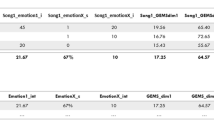Abstract
We present an extension to knowledge discovery in Music Information Retrieval (MIR) databases and the emotional indices associated with (i) various scalar theory, and (ii) correlative behavioral demographics. Certain societal demographics are set in their ways as to how they dress, behave in society, solve problems and deal with anger and other emotional states. It is also well documented that particular musical scales evoke particular states of emotion and personalities of their own. This paper extends the work that Knowledge Discovery in Databases (KDD) and Rough Set Theory has opened in terms of mathematically linking music scalar theory to emotions. We now, extend the paradigm by associating emotions, based from music, to societal demographics and how strong these relationships to music are as to affect, if at all, how one may dress, behave in society, solve problems and deal with anger and other emotional states.
Access this chapter
Tax calculation will be finalised at checkout
Purchases are for personal use only
Similar content being viewed by others
References
Baraldi, F.B., Poli, G.D., Rodà, A.: Communicating expressive intentions with a single piano note. J. New Music Res. 35(3), 197–210 (2006)
Cable Network Ranker: FNC No. 1 in Primetime for Week of March 9 (2015). http://adweek.it/1o3as2a. Accessed 05 May 2015
Eerola, T., Ferrer, R., Alluri, V.: Timbre and affect dimensions: evidence from affect and similarity ratings and acoustic correlates of isolated instrument sounds. Music Percept. Interdisc. J. 30(1), 49–70 (2012)
Espinoza, F.C., López-Ortega, O., Franco-Árcega, A.: Towards the automatic recommendation of musical parameters based on algorithm for extraction of linguistic rules. Computación y Sistemas 18(3), 637–647 (2014)
Estiri, H.: A structural equation model of energy consumption in the united states: untangling the complexity of per-capita residential energy use. Energy Res. Soc. Sci. 6, 109–120 (2015)
Gabrielsson, A., Lindström, E.: The influence of musical structure on emotional expression (2001)
Grahn, J.A., Henry, M.J., McAuley, J.D.: Fmri investigation of cross-modal interactions in beat perception: audition primes vision, but not vice versa. Neuroimage 54(2), 1231–1243 (2011)
Hevner, K.: Experimental studies of the elements of expression in music. Am. J. Psychol. bf–48, 246–268 (1936)
Lahdelma, I., Eerola, T.: Single chords convey distinct emotional qualities to both naïve and expert listeners. Psychol. Music 39, 1–18 (2014)
Leman, M., Vermeulen, V., De Voogdt, L., Moelants, D., Lesaffre, M.: Prediction of musical affect using a combination of acoustic structural cues. J. New Music Res. 34(1), 39–67 (2005)
Lewis, R., Raś, Z.: Facial recognition. In: Wang, J. (ed.) Encyclopedia of Data Warehousing and Mining, vol. II, 2nd edn, pp. 862–871. Idea Group Inc., Hershey (2008)
Lewis, R., Zhang, X., Raś, Z.: Knowledge discovery based identification of musical pitches and instruments in polyphonic sounds. Int. J. Eng. Appl. Artif. Intell. Special Issue on ‘Soft Computing Applications’ 20(5), 637–645 (2006)
Lewis, R.A., Zhang, X., Raś, Z.W.: Blind signal separation of similar pitches and instruments in a noisy polyphonic domain. In: Esposito, F., Raś, Z.W., Malerba, D., Semeraro, G. (eds.) ISMIS 2006. LNCS (LNAI), vol. 4203, pp. 228–237. Springer, Heidelberg (2006)
Lewis, R.A., Ras, Z.W.: Rules for processing and manipulating scalar music theory. In: International Conference on Multimedia and Ubiquitous Engineering, MUE 2007, pp. 819–824. IEEE (2007)
Lewis, R.A., Zhang, X., Raś, Z.W.: Knowledge discovery-based identification of musical pitches and instruments in polyphonic sounds. Eng. Appl. Artif. Intell. 20(5), 637–645 (2007)
McClellan, R.: The Healing Forces of Music. Element Inc., Rockport (1966)
Menon, V., Levitin, D., Smith, B.K., Lembke, A., Krasnow, B., Glazer, D., Glover, G., McAdams, S.: Neural correlates of timbre change in harmonic sounds. Neuroimage 17(4), 1742–1754 (2002)
Cable news ratings for thursday, March 5, 2015. TVbytheNumbers (2015)
Pavel, I.: A hierarchical theory of aesthetic perception - musical scales in theoretical perspectives prometheus. Leonardo 27(5), 417–421 (1994)
Raś, Z.W., Zhang, X., Lewis, R.: MIRAI: multi-hierarchical, FS-tree based music information retrieval system. In: Kryszkiewicz, M., Peters, J.F., Rybiński, H., Skowron, A. (eds.) RSEISP 2007. LNCS (LNAI), vol. 4585, pp. 80–89. Springer, Heidelberg (2007)
Schedl, M., Gómez, E., Urbano, J.: Music information retrieval: recent developments and applications. Found. Trends Inf. Retrieval 8(2–3), 127–261 (2014)
Schutz, M., Huron, D., Keeton, K., Loewer, G.: The happy xylophone: acoustics affordances restrict an emotional palate. Empirical Musicol. Rev. 3, 126–135 (2008)
Sevgen, A.: The Science of Musical Sound. ScientificAmerican Books Inc., New York (1983)
Smith, R., Rathcke, T., Cummins, F., Overy, K., Scott, S.: Communicative rhythms in brain and behaviour. Philos. Trans. Royal Soc. B: Biol. Sci. 369(1658), 20130389 (2014)
TVBGeneralGlossary (2015). http://www.tvb.org/planning_buying/4757. Accessed 05 May 2015
Wieczorkowska, A., Synak, P., Lewis, R., Ras, Z.: Creating reliable database for experiments on extracting emotions from music. In: Kłopotek, M.A., Wierzchon, S.T., Trojanowski, K. (eds.) Intelligent Information Processing and Web Mining, pp. 395–402. Springer, Heidelberg (2005)
Zentner, M., Grandjean, D., Scherer, K.R.: Emotions evoked by the sound of music: characterization, classification, and measurement. Emotion 8(4), 494 (2008)
Author information
Authors and Affiliations
Corresponding author
Editor information
Editors and Affiliations
Rights and permissions
Copyright information
© 2015 Springer International Publishing Switzerland
About this paper
Cite this paper
Lewis, R., Bihn, M., Mello, C. (2015). Machine Intelligence: The Neuroscience of Chordal Semantics and Its Association with Emotion Constructs and Social Demographics. In: Esposito, F., Pivert, O., Hacid, MS., Rás, Z., Ferilli, S. (eds) Foundations of Intelligent Systems. ISMIS 2015. Lecture Notes in Computer Science(), vol 9384. Springer, Cham. https://doi.org/10.1007/978-3-319-25252-0_32
Download citation
DOI: https://doi.org/10.1007/978-3-319-25252-0_32
Published:
Publisher Name: Springer, Cham
Print ISBN: 978-3-319-25251-3
Online ISBN: 978-3-319-25252-0
eBook Packages: Computer ScienceComputer Science (R0)




